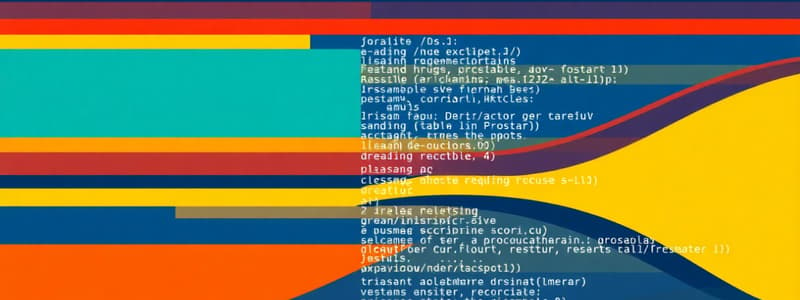Podcast
Questions and Answers
What occurs during a context switch?
What occurs during a context switch?
- The operating system completes its operations without interruption.
- The system executes a new process without saving the old state.
- The state of the running process is saved and the new process state is loaded. (correct)
- The CPU runs multiple processes simultaneously.
Which factor can lengthen the context-switch time?
Which factor can lengthen the context-switch time?
- Using a single set of registers per CPU. (correct)
- Simple operating systems with fewer PCB entries.
- Having fewer processes in the ready state.
- Enhanced hardware that provides multiple sets of registers.
What is true about pre-emption in the context of multiprogramming?
What is true about pre-emption in the context of multiprogramming?
- It can lead to starvation of processes needing continuous CPU access.
- It increases the overall time for all processes to complete.
- Processes are allowed to run until completion without interruption.
- Processes are forcefully removed from the CPU to allocate time to others. (correct)
How is the degree of multiprogramming defined?
How is the degree of multiprogramming defined?
Which of the following statements is accurate regarding context switching?
Which of the following statements is accurate regarding context switching?
What is a process in the context of an operating system?
What is a process in the context of an operating system?
What must happen for a program to become a process?
What must happen for a program to become a process?
Which of the following is NOT a component of a process?
Which of the following is NOT a component of a process?
In which type of system are user programs or tasks executed simultaneously?
In which type of system are user programs or tasks executed simultaneously?
Which of the following sections of a process contains temporary data such as function parameters and local variables?
Which of the following sections of a process contains temporary data such as function parameters and local variables?
What is the primary function of the program counter in a process?
What is the primary function of the program counter in a process?
Which of the following best describes 'interprocess communication'?
Which of the following best describes 'interprocess communication'?
What does the term 'heap' refer to in the context of a process?
What does the term 'heap' refer to in the context of a process?
What is one of the primary reasons for terminating a child process?
What is one of the primary reasons for terminating a child process?
What system call is typically used for process termination?
What system call is typically used for process termination?
Which condition can lead to the termination of a process due to resource limitations?
Which condition can lead to the termination of a process due to resource limitations?
What happens to a child process if its parent process is terminated?
What happens to a child process if its parent process is terminated?
What is cascading termination in relation to process management?
What is cascading termination in relation to process management?
What information is typically NOT included in a Process Control Block (PCB)?
What information is typically NOT included in a Process Control Block (PCB)?
What is the primary purpose of process scheduling in an operating system?
What is the primary purpose of process scheduling in an operating system?
A process may be terminated if it tries to access which of the following?
A process may be terminated if it tries to access which of the following?
What occurs if an I/O failure happens in relation to process termination?
What occurs if an I/O failure happens in relation to process termination?
Which of the following best describes a running process in terms of its state?
Which of the following best describes a running process in terms of its state?
What system call might a parent process use to wait for the termination of a child process?
What system call might a parent process use to wait for the termination of a child process?
In a multiprogramming operating system, what is a key factor that allows multiple processes to share the CPU?
In a multiprogramming operating system, what is a key factor that allows multiple processes to share the CPU?
Which of the following is NOT part of the CPU registers information in a PCB?
Which of the following is NOT part of the CPU registers information in a PCB?
What happens to a process during a context switch?
What happens to a process during a context switch?
What characteristic is essential for a multiprogramming operating system?
What characteristic is essential for a multiprogramming operating system?
Which of the following best describes I/O status information in a PCB?
Which of the following best describes I/O status information in a PCB?
What occurs when both the sender and receiver are blocked in a message-passing scenario?
What occurs when both the sender and receiver are blocked in a message-passing scenario?
Which type of send operation allows the sender to continue without waiting for the recipient to receive the message?
Which type of send operation allows the sender to continue without waiting for the recipient to receive the message?
What is the consequence of a zero capacity queue in message buffering?
What is the consequence of a zero capacity queue in message buffering?
In the context of blocking and non-blocking operations, which of the following is true about blocking receive operations?
In the context of blocking and non-blocking operations, which of the following is true about blocking receive operations?
What type of message passing is characterized by a sender being blocked until the message is received?
What type of message passing is characterized by a sender being blocked until the message is received?
Which statement correctly describes the behavior of a non-blocking receive operation?
Which statement correctly describes the behavior of a non-blocking receive operation?
How can a producer-consumer problem be simplified in a message-passing context?
How can a producer-consumer problem be simplified in a message-passing context?
Which of the following combinations results in a rendezvous during message passing?
Which of the following combinations results in a rendezvous during message passing?
Study Notes
Process Concept
- A program being executed is called a process.
- A process is an active entity that represents the basic unit of work in a system.
- A process is comprised of multiple parts:
- Program code (text section)
- Current activity (program counter, processor registers)
- Stack (temporary data, function parameters, return addresses, local variables)
- Data section (global variables)
- Heap (dynamically allocated memory)
- A program is a passive entity stored on disk (executable file).
- A program becomes a process when loaded into memory.
Process State
- A diagram of the process state depicts a process moving between states:
- New: The process is being created.
- Running: The process is currently using the CPU.
- Waiting: The process is waiting for an event, such as I/O completion.
- Ready: The process is waiting to be assigned to the CPU.
- Terminated: The process has completed execution.
Process Control Block (PCB)
- The PCB (Process Control Block), also known as the task control block, holds information associated with each process.
- The PCB contains:
- Process state
- Program counter (location of the next instruction to execute)
- CPU registers (contents of all process-centric registers)
- CPU scheduling information (priorities, scheduling queue pointers)
- Memory management information (memory allocated to the process)
- Accounting information (CPU usage, elapsed time, time limits)
- I/O status information (I/O devices allocated, list of open files)
Process Scheduling
- Process scheduling optimizes CPU usage and facilitates time-sharing by quickly switching processes on and off the CPU.
- The process scheduler decides which process runs next.
- Process scheduling is a key component of multiprogramming operating systems.
Context Switch
- A context switch occurs when the CPU transitions from one process to another.
- The system saves the state of the old process and loads the saved state of the new process.
- The context switch involves saving and restoring the contents of the PCB.
- Context switch time is overhead, as the system isn't performing useful work during the switch.
- Faster hardware, like CPUs with multiple sets of registers, can reduce context switch time.
Multiprogramming
- Multiprogramming allows multiple processes to reside in memory simultaneously.
- Two types of multiprogramming:
- Pre-emption: A process is forcefully removed from the CPU (time-sharing, multitasking).
- Non-pre-emption: Processes run until completion without interruption.
- The degree of multiprogramming indicates the maximum number of processes that can be in the ready state.
Process Termination
-
A process can be terminated due to various reasons:
- Normal completion of execution
- Parent process request
- Resource violation (e.g., attempting to write to a read-only file)
- I/O failure
- Parent process termination (cascading termination)
- Memory shortage
-
The wait() system call allows a parent process to wait for a child process to terminate.
Synchronization
- Message passing is a method of inter-process communication (IPC) and can be blocking or non-blocking.
- Blocking message passing is synchronous:
- Blocking send: The sender process blocks until the message is received.
- Blocking receive: The receiver process blocks until a message is available.
- Non-blocking message passing is asynchronous:
- Non-blocking send: The sender sends the message and continues execution.
- Non-blocking receive: The receiver receives either a valid message or a null message.
Buffering
- Buffering is a technique used in message passing involving a queue of messages attached to a communication link.
- Buffering options include:
- Zero capacity: No messages can be queued, requiring the sender to block until the receiver processes the message.
Studying That Suits You
Use AI to generate personalized quizzes and flashcards to suit your learning preferences.
Related Documents
Description
Explore the fundamental concepts of processes in operating systems. Understand how a program becomes an active process, the different states of a process, and the components that make up a process. Test your knowledge of this essential topic in system management.




